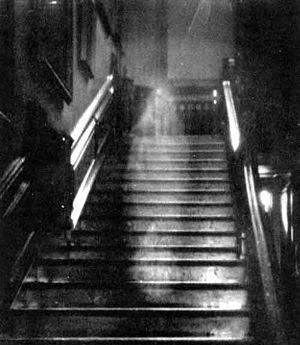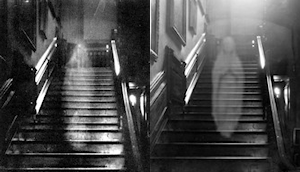
Wikimedia Commons
The Brown Lady of Raynham Hall is a ghost said to haunt Raynham Hall in Norfolk, England. Its fame was established when a spirit photographTechnique popular in the 19th century to capture the invisible spirits of the deceased. – probably the most famous of a ghost ever taken[2] – was published in the Boxing Day edition of Country Life magazine in 1936.
According to family legend, the ghost is that of Lady Dorothy Walpole (1686–1726), the sister of Robert Walpole, generally considered to be the first prime minister of Great Britain.[3] Dorothy was the second wife of Charles Townshend, popularly known as Turnip Townshend,[a]Charles Townshend introduced the four-crop “Norfolk rotation”: turnips, barley or oats, clover or rye, and wheat, which meant that the land did not need to lie fallow. A condition of the leases he offered tenant farmers was often that they grew turnips.[4] someone described by his biographers as “a passionate man who loved and hated quickly and rarely changed his mind once an opinion had been formed”.[4] The story says that when Townshend discovered his wife had had an affair with Lord Wharton, he punished her by locking her in her rooms in the family home, Raynham Hall, where she remained until her death from smallpox in 1726.[4] In alternative versions of the legend Dorothy died after falling down stairs, or from syphilis contracted from her supposed lover, Lord Wharton.[5]
Early sightings

artnet
Sightings of the Brown Lady have been reported since at least the 1830s.[3] The apparition takes its name from the brown brocade dress it is seen wearing, but its most striking feature is the empty black sockets where its eyes should be.[6]
In 1836 the author Frederick Maryatt, better known as Captain Maryatt, decided to investigate the ghost, believing it to be connected to some kind of criminal activity, possibly smuggling. For two nights he slept in the supposedly haunted room in which Dorothy’s portrait hung, with a loaded pistol under his pillow, and on the third night the apparition appeared. He recognised it as Dorothy from the portrait and discharged his pistol, but the bullet passed straight through its target. A relative of the Townshends, Major Loftus, while staying with the family over Christmas 1849, is reported as having encountered the ghost several times; his account of the experience resulted in the resignation of the staff of Raynham Hall. In 1936 Lady Townshend wrote that the Brown Lady had been seen “quite recently” by her brother-in-law’s sister.[7]
The Brown Lady is by no means the only ghost said to haunt Raynham Hall; others include a Red Cavalier, a child, and a cocker spaniel. Writing as Gwladys Townshend of Raynham, Lady Townshend had collaborated with Maude Ffoulkes on a volume entitled True Ghost Stories (1936), to which she contributed a chapter on the ghosts of Raynham Hall.
Indre Shira
Shortly after the publication of True Ghost Stories, Lady Townshend received a letter from someone who identified himself as Indre Shira, claiming to be an established court photographer and asking for permission to visit Raynham Hall to photograph the Brown Lady. She turned down his request for an overnight stay, but did agree to him visiting for a day on 19 September.[2]
Indre Shira and his art director, Captain Hubert Provand, spent the day taking photographs around the hall. At about 4 pm, as they were setting up to take a picture of one of the staircases on the ground floor, Shira saw “an ethereal, veiled form coming slowly down the stairs”. Provand saw nothing, but he uncapped the camera’s lens and took a photograph while Shira triggered the flash.[3] Examining the negative back in their studio at 49 Dover Street in Piccadilly, sure enough there was an “inexplicable shape”; Shira called for the manager of the chemists shop downstairs to witness the negative being developed. The photograph subsequently appeared in the 26 December issue of Country Life in the UK, and the December issue of Life magazine in the US.[8]
Curiously, given its later attribution, the accompanying editorial in Country Life explicitly states that the image is not that of the Brown Lady, and Shira himself describes the apparition simply as the Raynham Ghost.[9] Lady Townshend, a devout Catholic, believed it to be the Virgin Mary.[10][b]Lady Townshend kept a Catholic shrine beneath the staircase.[10]
When the well-known psychic, Dr Nandor Fodor, visited Raynham Hall on 8–9 January 1937 and attempted to replicate Shira’s photograph, Lady Townshend confided to him that she was surprised Shira had said nothing to her at the time about seeing the apparition.[11] Fodor expressed his view to the marchioness that “Indre Shira is out to make capital of your ghost”.
Early investigation
Within weeks of the photograph’s publication, the Society for Psychical ResearchRegistered charity founded in 1882 to conduct scientific investigations into psychic and paranormal phenomena. (SPR) launched an investigation led by C. V. C. Herbert, “one of the most flawed investigations ever undertaken by the SPR” in the view of paranormal researcher Roger Clarke.[12] Herbert’s conclusion was that the bellows of the old camera used by Provand may have allowed the ingress of light, but he left open the possibility of a double exposure. Herbert also revealed that “Indre Shira” was a pseudonym, but of whom he was unwilling to say.[13] The name may have been borrowed from Madame Indre Shira, “a moderately successful society psychic, palmist and astrologer in 1930s London”.[14]
Possible explanation
 | |
Original photograph left, Morgan’s reproduction right. Wikimedia Commons, xenophon.org.uk | |
It is unclear when claims that the photograph captured the ghost of the Brown Lady began to circulate, but the image bears very little resemblance to the earlier descriptions of Dorothy Walpole’s ghost, looking more like conventional representations of the Virgin Mary, which is what Lady Townshend initially identified it as. In the course of his investigation into the photograph, Roger J. Morgan attempted to duplicate the image using a statuette of the Madonna, during which he estimated the height of the ghostly image in Shira’s photograph to be a little more than four feet (1.2 m) based on the height of the stair risers, rather diminutive for the Virgin Mary.[14]
According to Sir Arthur Conan Doyle, the first ghost photographTechnique popular in the 19th century to capture the invisible spirits of the deceased. was the result of an accident caused by not properly cleaning the reusable glass plates then used to produce the negatives, with the result that one image bled through into another. The technique was subsequently widely used to produce “imposture on an almost industrial scale”.[15]
The camera used to take the picture of the Brown Lady used Kodak S.S. Ortho film, not reusable glass plates,[1] but a similar effect can be achieved by superimposing one negative on top of another.
The two negatives would be put together and when printed the staircase would show through the other negative, making it appear that the figure was standing on one of the stairs.[3]
Of course any number of demonstrations of how the photograph could have been faked do not prove that it was. One thing seems clear however; whatever is shown on the image is unlikely to be the ghost of the Brown Lady, as “observers described a far more life-like and complex form than the luminous blur in the photograph taken by Provand and Shira”.[1] Fodor’s suggestion to Lady Townshend of a possible financial motive must have gained credence when 8×10 prints were advertised outside the chemists shop for sale at one guinea each, equivalent to about £70 as at 2019.[16][c]Using the retail price index.[17]
Notes
| a | Charles Townshend introduced the four-crop “Norfolk rotation”: turnips, barley or oats, clover or rye, and wheat, which meant that the land did not need to lie fallow. A condition of the leases he offered tenant farmers was often that they grew turnips.[4] |
|---|---|
| b | Lady Townshend kept a Catholic shrine beneath the staircase.[10] |
| c | Using the retail price index.[17] |
